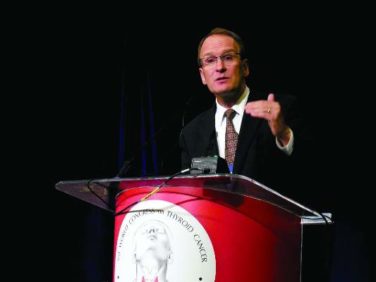FROM JAMA
Treating acute respiratory distress syndrome patients with helmets instead of face masks significantly reduced intubation rates and 90-day mortality rates, based on data from a randomized trial of 83 adults published in JAMA.
Acute respiratory distress syndrome (ARDS) can be treated using a face mask, but the mask is often inadequate, forcing patients to undergo intubation that can lead to additional problems including discomfort, delirium, and muscle deterioration, wrote Tianna Hicklin, Ph.D. , in a column on the NIH website.
“The proposed mechanism for improved efficacy of these helmets is the preservation of applied pressures and avoidance of air leak. If the helmets indeed do allow clinicians both to be able to increase airway pressures above levels they typically would with mask-NIV and maintain those pressures without unpredictable system leak, that would be of great physiologic importance for patients with acute respiratory failure,” said Dr. Eric J. Gartman.
To explore the potential of noninvasive ventilation (NIV) using a helmet instead of a mask, both of which allow patients to remain awake in the ICU, the researchers randomized 83 adults with ARDS to treatment with either a helmet (44 patients) or a face mask (39 patients).
Intubation incidence was 18% in patients treated with helmets, compared with 62% for those treated with face masks. In addition, patients in the helmet group had significantly more ventilator-free days than the mask group (28 vs. 13; P less than .001), and both hospital mortality and 90-day mortality rates were significantly lower in the helmet group compared to the mask group (27% vs. 49%; P = .04 and 34% vs. 56%; P = .02, respectively)
Adverse event rates were rare, and similar between the helmet and mask groups. Three interface-related skin ulcers occurred in each group; nose ulcers in 7% of the mask group and neck ulcers in 7% of the helmet group.
The study population included adults aged 18 years and older who were admitted to the ICU at the University of Chicago between September 2012 and September 2015 and required face mask NIV. The average age of the patients was 58 years in the helmet group and 61 years in the mask group; there were no significant demographic differences between the groups. The most common causes of acute respiratory failure in both groups were pneumonia and pneumonia caused by immunosuppression.
The study results were limited by several factors including a lack of blinding, the need for a learning curve for clinicians using the helmet, and the potential for patient-ventilator dyssynchrony in the helmet group, noted Dr. Bhakti K. Patel of the University of Chicago and her colleagues ( JAMA 2016;315:2435-41 ). Multicenter studies are needed to support the findings, they added. However, the findings “affirm the far-reaching benefits of spontaneous yet highly supported ventilation in an awake, animated patient over invasive medical ventilation via endotracheal tube,” they wrote. “These findings warrant further investigation of helmet NIV for patients with ARDS and other types of AHRF [acute hypoxemic respiratory failure], particularly with attention to long-term outcomes.”
The researchers had no financial conflicts to disclose.
“While the results of this study are very impressive, it is a single-center study, and obviously a larger multicenter trial (with all types of institutions included – not just large academic centers) would be helpful to elucidate the benefit of this technique and support a change in standard of care in the use of NIV. A change to this system would be a very large culture shift in NIV and would mean a significant amount of training (physician, nursing, respiratory care), purchasing the helmets, and ensuring that it is implemented properly and safely. As stated by the authors, this fact is similar to the change the occurred originally with NIV – but if their results reflect a true benefit over FM-NIV [face mask-noninvasive ventilation], such a large change would certainly be worth the effort,” Dr. Gartman said.
In a related study published in the Journal of Cardiothoracic and Vascular Anesthesia, patients treated with noninvasive positive pressure ventilation (NPPV) through helmets had significantly lower heart rates, lower average arterial pressure, and improved left ventricular ejection fraction at the end of treatment, compared with patients treated with ventilation masks and controls. Dr. Yi Yang of Capital Medical University in Beijing, China, and colleagues conducted the prospective study of 75 adults experiencing hypoxemia within 24 hours of extubation after Stanford type A aortic dissection. The participants were divided into three 25-patient groups. The control group was treated with high-flux inhalation of oxygen via a Venturi mask, another group was treated with NPPV via a mask, and the third group was treated with NPPV via a helmet. ( J Card Vasc Anesth. 2016. http://dx.doi.org/10.1053/j.jvca.2016.03.129 ).
The study was funded by China’s public welfare industry of health.





